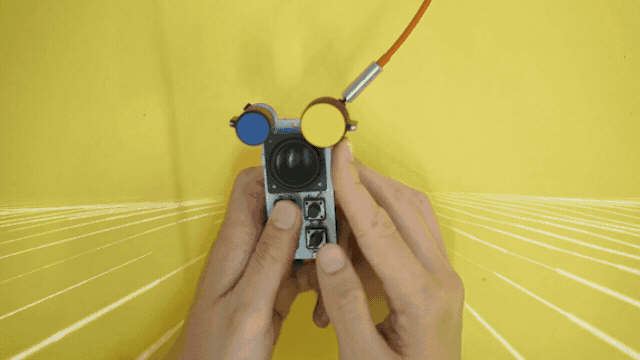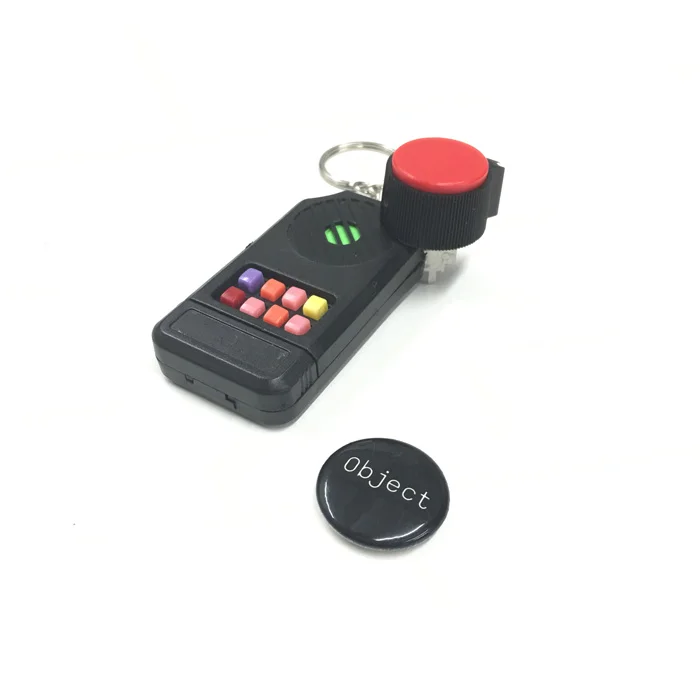Patient Alpha Circuit Bending Kit
Patient Alpha Circuit Bending Kit
Price includes free shipping in the US!
Born in the 80s, Patient Alpha came in need of a 21st century update. If you're curious about circuit bending, this keychain noise machine is easy to get into, and has some depth to explore.
Once the operation is complete, turning the knob varies the rate of playback for all sorts of crazy sounds.
The kit comes with:
Keychain w/ batteries
Potentiometer
Big red knob
Four resistors resistors
Headphone out jack
Curious Sound Objects button
Tools required: soldering iron a must, dremel tool a strong plus.
Sign up for the newsletter for updates here
(once a month tops)
Full instructions here
Patient Alphas
by friends of Curious Sound Objects
The Marcelo
Matte gray body, blue guttons, purple grill.
Side knob. By Marcelo Coelho and Brian Rossa
Ectocooler
Black body, lime green grill/buttons, exposed potentiometer, headphone out, and the Slimer mod (touching the exposed circuit on the top left slows the sound way down). By Kool Teem
Victorious
White body, gold buttons, purple grill
by Victoria Cabot and David Cranor
Night Mode
All black, custom laser cut knob
by Victoria Cabot
Introduction to Circuit Bending
with the Patient Alpha
What can I bend?
You can find which parts of the board are bendable by licking your finger! Open up a battery powered device and run a finger over different parts of the board while triggering a sound. In this case, the board is super simple and there is one resistor to the right of the black blob that makes the patient squirm. The eight pads are for the buttons, and you need to push them with something metal to make that connection – tweezers can be fiddly. I used a finger wrapped in foil next, and ultimately some foil taped around the bottom of a tool.
Vary that resistor
Poking around with your slightly wet (or aluminum foil covered) finger changes the way electricity flows through and around the components in a circuit. It's possible to reverse engineer a circuit to a certain degree, but it's faster and more fun when circuit bending to poke around and see which components make interesting sounds happen.
That tiny thing with the numbers is a surface mount resistor. I noticed that when I touched the resistor, the sound would speed up or slow down. Which makes me think that this resistor is part of the master oscillator for the sound circuit. Looks like we found our first organ to replace!
Resistors are rated in ohms, and this resistor is 220k. You can figure this out from the numbers – the first two numbers multiplied by 10 to the power of the third number.
In this case, 224 is:
22 times 10 to the power of 4 = 220,000 or 220 kilo ohms.
So why don't we replace that resistor with a potentiometer (a variable resistor) and see what happens?
The Easy Peasy Mod
Start by removing the original resistor.
The potentiometer that comes with the kit is 100k and soldering it into the previous resistor terminals (1) and (2) makes for a clean 0-100k range, which sounds sort of "fast" to "superfast." This works well.
Plugging it into terminals (1), (2), and (3 - power), does some sort of voodoo and goes from superfast at the top, down to slow, then a hair of superslow, then dead space at the bottom. It may also drain the battery. So not advisable, but it is fun to see the whole range.
If you want to do this easy mod, use only (1) and (2) and bend the third pot terminal down. It will be fun, but you can get more slow end with other mods...









